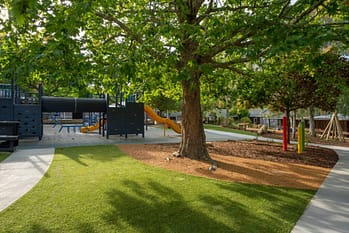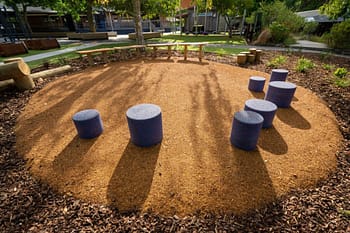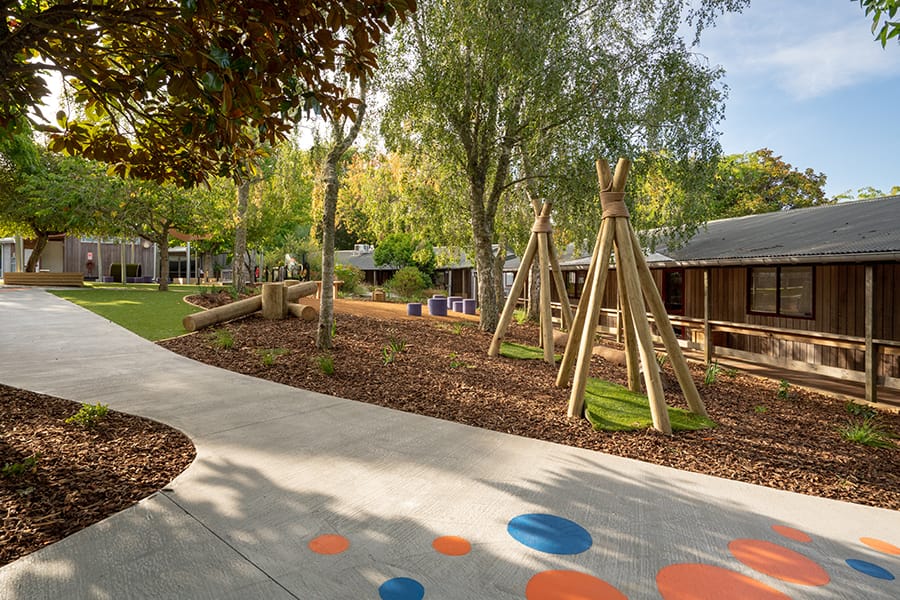While still important, swings and slides no longer dominate New Zealand’s school playground design. Nowadays schools are taking learning outside, taking children on a journey, and taking everyday play above and beyond.
There is no one factor in this revolution of play space. Instead it’s the combination of changing mindsets, design expertise and equipment innovation that is now driving our schools forward (and up and through and over and around).
With further evidence showing how play supports and sustains learning (and vice versa), forward-thinking schools in New Zealand are now taking their outdoor spaces to the next level. In doing so they are ensuring their playgrounds are fit for (multi)purpose use across the years to come.
The smart investment in school landscaping is now being made in adaptable and flexible spaces, ensuring unique features create a point of difference for the school and allowing for a more holistic approach to both learning and playing. In doing so schools are making the most of what space they’ve got, with each and every area used efficiently and effectively.
We take a look here at the key factors in playgrounds designed to bring out the best of children, the teachers, the school and its community.
Check out our 25 ways to activate underutilised space in your school
1. Nature can be balanced with nurture.

Blending the best from both natural and artificial environments is ensuring children can learn from important ecological areas while also enjoying all the convenience, safety and creativity from the bright and bold play spaces. With the right design approach everything clicks into place properly too – an artificial court can look perfect next to a butterfly garden or secret circle.
This approach also helps schools avoid some of the ongoing maintenance costs typical of traditional play spaces. New areas with innovative surfacing can be essentially maintenance-free, allowing greater focus on keeping the natural spaces growing and thriving.
2. Outdoor space is for learning too.

Creating greater flow from the building to the outdoor area is breaking down traditional barriers and allowing teachers to take a break from the confines of the classroom.
Shade structures provide sun protection and, in some cases, waterproofing for wet weather play and learning too. These well-designed areas ensure teachers can maintain line-of-sight outdoor supervision from within the classroom – so children can work outdoors in a safe and secure environment. Such spaces can be easily adapted too – transforming from the busy physicality at break time to studious philosophy during learning hours.
3. ‘New’ can be balanced with ‘old’.

The modern school play environment offers the best of both worlds, with great traditional equipment and innovative new design combining to stimulate imagination into action.
The big changes have started at ground level. Dust in summer and mud in winter is minimized (although there is still space for such nature play). No longer do messy bark chips get tracked through the school. Now surfacing options such as Pour’n’Play can be molded and shaped into mounds and hills, providing critical fall height protection while delivering colour and ongoing durability. So too have the obstacles changed, allowing for more vaulting, leaping and climbing. These types of play encourage children to push their limits in creative and dynamic ways.
4. There is no such thing as ‘nothing space’.

With new building or extension work schools are often left with areas where nothing much is going on. With a comprehensive master plan outdoor spaces can be linked together and previous ‘dead areas’ between or behind buildings can now provide both hidden delights and useful resources.
Here there are a huge number of ways to activate this type space. Unused wall areas can be transformed into climbing spaces with protective surfacing, or beautiful green walls or even fantastic interactive music walls. Areas of concrete that might easily become shabby instead can be transformed into mazes or scooter tracks. Gardens can become established for butterflies and bird life with stone steppers or logs and nature play added. Indeed, with an expert designer onboard these previous dead spaces will come alive with action and excitement.
To access 25 ways to activate underutilised space in your school click here.
5. Building is better (and faster and more cost-effective too).

Schools have struggled in the past having to deal with multiple contractors and silos of information and project inefficiencies that inevitably come with it.
With an integrated approach from a design-build team no project phase now occurs in isolation and schools don’t need to manage multiple meetings with six different people. As a result projects are being delivered far faster than what was previously possible, ensuring less overall cost for the school and far less disruption to everyday operation. Find out more about the design-build process by clicking here.
With creativity happening at a far earlier stage of the playground process the entire space can be expanded to cover both play and learning experiences.
Discover how to deliver play and plan for a successful school future – check out our 25 ways to activate underutilised space in your school.




